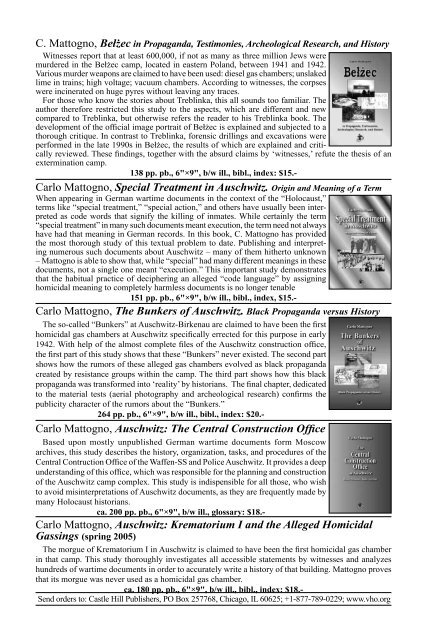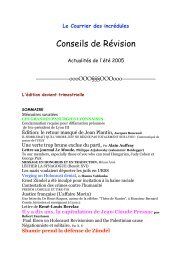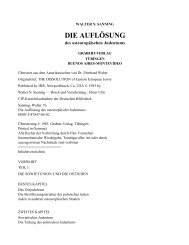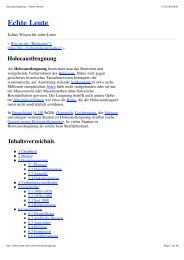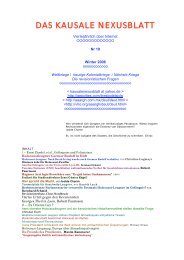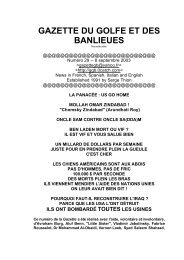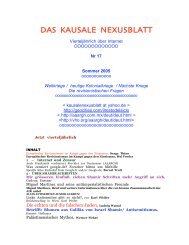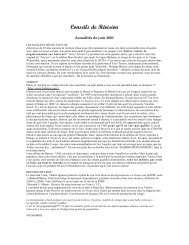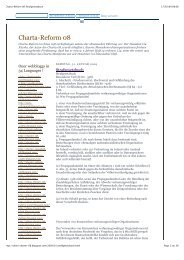You also want an ePaper? Increase the reach of your titles
YUMPU automatically turns print PDFs into web optimized ePapers that Google loves.
C. Mattogno, Be��ec in Propaganda, Testimonies, Archeological Research, and History<br />
Witnesses report that at least 600,000, if not as many as three million Jews were<br />
murdered in the Be��ec camp, located in eastern Poland, between 1941 and 1942.<br />
Various murder weapons are claimed to have been used: diesel gas chambers; unslaked<br />
lime in trains; high voltage; vacuum chambers. According to witnesses, the corpses<br />
were incinerated on huge pyres without leaving any traces.<br />
For those who know the stories about Treblinka, this all sounds too familiar. <strong>The</strong><br />
author therefore restricted this study to the aspects, which are different and new<br />
compared to Treblinka, but otherwise refers the reader to his Treblinka book. <strong>The</strong><br />
development of the offi cial image portrait of Be��ec is explained and subjected to a<br />
thorough critique. In contrast to Treblinka, forensic drillings and excavations were<br />
performed in the late 1990s in Be��ec, the results of which are explained and critically<br />
reviewed. <strong>The</strong>se fi ndings, together with the absurd claims by ‘witnesses,’ refute the thesis of an<br />
extermination camp.<br />
138 pp. pb., 6"×9", b/w ill., bibl., index: $15.-<br />
Carlo Mattogno, Special Treatment in <strong>Auschwitz</strong>. Origin and Meaning of a Term<br />
When appearing in German wartime documents in the context of the “Holocaust,”<br />
terms like “special treatment,” “special action,” and others have usually been interpreted<br />
as code words that signify the killing of inmates. While certainly the term<br />
“special treatment” in many such documents meant execution, the term need not always<br />
have had that meaning in German records. In this book, C. Mattogno has provided<br />
the most thorough study of this textual problem to date. Publishing and interpreting<br />
numerous such documents about <strong>Auschwitz</strong> – many of them hitherto unknown<br />
– Mattogno is able to show that, while “special” had many different meanings in these<br />
documents, not a single one meant “execution.” This important study demonstrates<br />
that the habitual practice of deciphering an alleged “code language” by assigning<br />
homicidal meaning to completely harmless documents is no longer tenable<br />
151 pp. pb., 6"×9", b/w ill., bibl., index, $15.-<br />
Carlo Mattogno, <strong>The</strong> <strong>Bunkers</strong> of <strong>Auschwitz</strong>. Black Propaganda versus History<br />
<strong>The</strong> so-called “<strong>Bunkers</strong>” at <strong>Auschwitz</strong>-Birkenau are claimed to have been the fi rst<br />
homicidal gas chambers at <strong>Auschwitz</strong> specifi cally errected for this purpose in early<br />
1942. With help of the almost complete fi les of the <strong>Auschwitz</strong> construction offi ce,<br />
the fi rst part of this study shows that these “<strong>Bunkers</strong>” never existed. <strong>The</strong> second part<br />
shows how the rumors of these alleged gas chambers evolved as black propaganda<br />
created by resistance groups within the camp. <strong>The</strong> third part shows how this black<br />
propaganda was transformed into ‘reality’ by historians. <strong>The</strong> fi nal chapter, dedicated<br />
to the material tests (aerial photography and archeological research) confi rms the<br />
publicity character of the rumors about the “<strong>Bunkers</strong>.”<br />
264 pp. pb., 6"×9", b/w ill., bibl., index: $20.-<br />
Carlo Mattogno, <strong>Auschwitz</strong>: <strong>The</strong> Central Construction Offi ce<br />
Based upon mostly unpublished German wartime documents form Moscow<br />
archives, this study describes the history, organization, tasks, and procedures of the<br />
Central Contruction Offi ce of the Waffen-SS and Police <strong>Auschwitz</strong>. It provides a deep<br />
understanding of this offi ce, which was responsible for the planning and construction<br />
of the Ausch witz camp complex. This study is indispensible for all those, who wish<br />
to avoid misinterpretations of <strong>Auschwitz</strong> documents, as they are frequently made by<br />
many Holocaust historians.<br />
ca. 200 pp. pb., 6"×9", b/w ill., glossary: $18.-<br />
Carlo Mattogno, <strong>Auschwitz</strong>: Krematorium I and the Alleged Homicidal<br />
Gassings (spring 2005)<br />
<strong>The</strong> morgue of Krematorium I in <strong>Auschwitz</strong> is claimed to have been the fi rst homicidal gas chamber<br />
in that camp. This study thoroughly investigates all accessible statements by witnesses and analyzes<br />
hundreds of wartime documents in order to accurately write a history of that building. Mattogno proves<br />
that its morgue was never used as a homicidal gas chamber.<br />
ca. 180 pp. pb., 6"×9", b/w ill., bibl., index: $18.-<br />
Send orders to: Castle Hill Publishers, PO Box 257768, Chicago, IL 60625; +1-877-789-0229; www.vho.org


